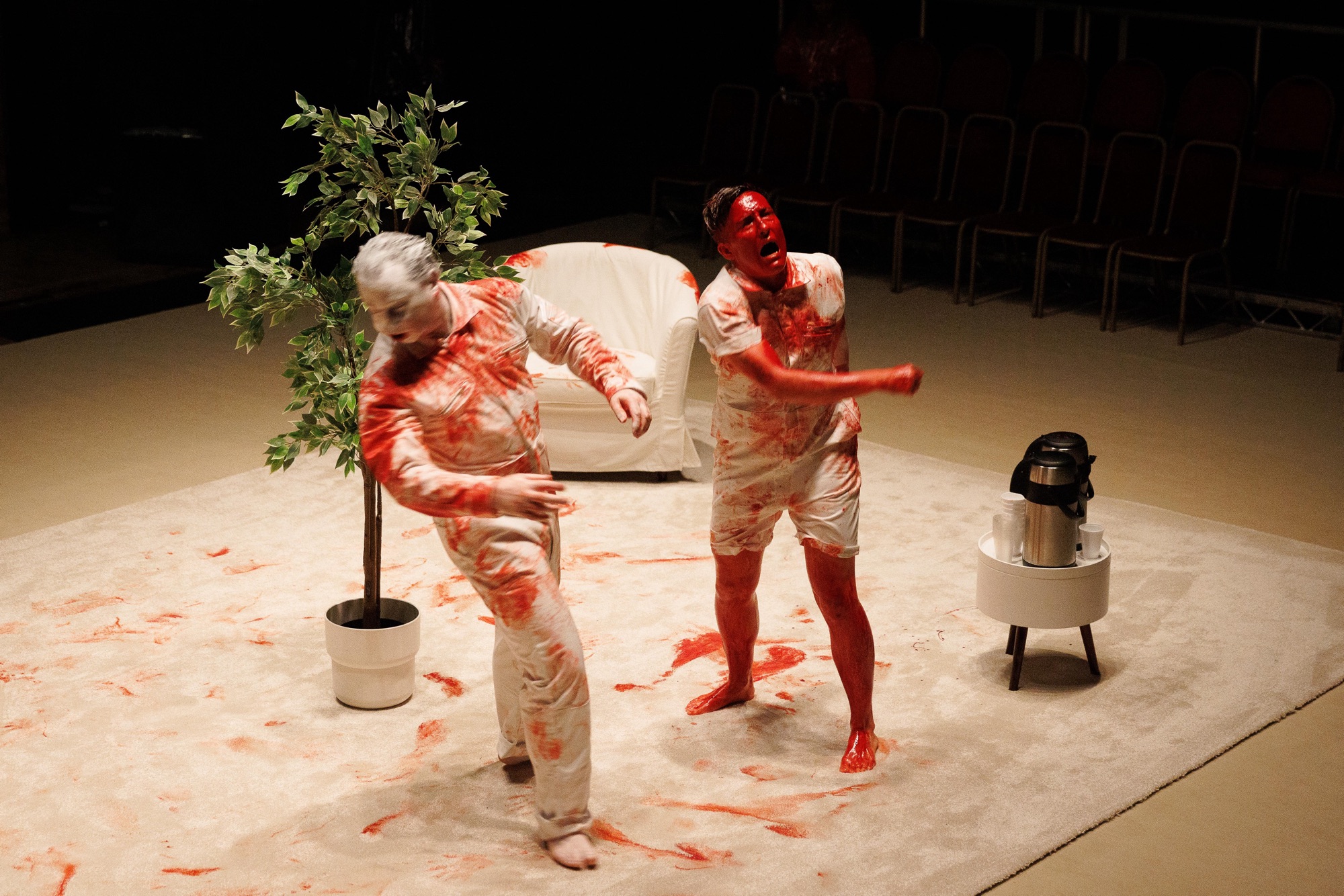By Ocean Chillingsworth. In this article Ocean reflects on the labour and tenderness of fight choreography.
It’s the artifice I love about fight choreography. It’s the NOTness I’m drawn to. The too-large gap between the face and the fist, which still feels like impact. The visible knap on the chest which, while our eyes know means it’s fake, our ears still believe. The ludicrous, confronting levels of violence, of excess, of the impossible that it allows us to conjure. The fact that it’s the reaction, rather than the action, that sells it. The joy that, looked at from the ‘right’ angle, the kick looks brutal, and from the ‘wrong’ angle, laughable. The this AND that. The being-the-thing and not-being-the-thing. And the fact that it is so ridiculously safe.
Blood Show is a fight choreography that loops, with the performers becoming increasingly worn down and done-in, not from violence but from the effort of simulating violence – the effort of intentionally not being violent. It’s an exhausting and precise sequence, which paints a picture of shambolic and rough physical conflict. I am no dancer (that’s putting it kindly) and have tended to think that choreography is not a landscape I can inhabit. I don’t have good rhythm and struggle to move gracefully to music. But working with Craig Hambling, the fight director and also my co-performer in Blood Show, has shown me that, really, this is a dance show. Craig has repeatedly impressed upon me, and demonstrated, that the only way fight choreography can work, is if it is safe. When you’re working with a form in which the risk is that you might, for example, be punched very hard in the face, this starts to make sense pretty quickly. So the holds we have on each other are exact. The distance between each other is exact. The distribution of balance as we do a move together is exact. And this total collaboration, delicate trust and exactitude is all in the name of making what’s happening look like a gnarly, gruesome fist fight in which anything might happen.
Craig says “Much of what I do with performers is to find ways to minimise performing. A neat example of this is the technique of the strangle – I wrap hands around your throat, but it is you who tries to choke yourself with my hands while I try my utmost to take them away. With my arms straight, my partner is far stronger than I and completely in control of the force applied to their body. This technique requires trust and an intimate communication, but it enables us to do something which is exhausting and, while being innately safe, almost indistinguishable from the grim reality. The force is misdirected, but the work is real and apparent. This is a microcosm of the whole choreography; our shared technique lets us know we cannot hurt one another, and this knowledge gives us permission to try – no performing required. We genuinely try to hit targets that are deliberately out of reach, and when they are in reach and we misdirect the energy of the strikes to safe areas, the energy is still real. Once the moves are choreographed and our technique is practiced enough, all that is left on stage is our connection with one another and our physical toil.”

This is a kind of dancing my body seems to understand. In some ways, it’s a very tender headspace (or, body space) to be in. It feels like saying: Let’s use our bodies in a totally caring and connected way to convince people, momentarily, that we’re trying to kill each other. And then let’s start again. And again. And again. There’s something so satisfying about how stage violence can simply ‘reset’. The most outrageous move can happen – an eye can be gouged out, a neck broken, teeth go flying – and then the performers can get up, take their positions, and be ready to start again. I’m not very interested in claiming dramatic consequence on stage – I prefer the actual consequence of labour and effort, with its associated sweat and breath. Someone asked me recently if performing Blood Show scares me. There are practicalities in the work that get my adrenaline going – not least grappling with 75 litres of stage blood per performance – but more than in any other work I’ve done, I don’t have time to be scared. Each moment is a hyper-present action, all doing, very little thinking, which only works if I fully commit to it, trust the other bodies on stage and trust the shapes we’re making to do the work. Maybe I am a bloody dancer after all.
Blood Show comes to Battersea Arts Centre from 12-23 November. Get your tickets here.
